All photographs except the first one and the last two are by the present author. You may use them without prior permission for any scholarly or educational purpose as long as you (1) credit the photographer and (2) link your document to this URL in a web document or cite The Victorian Web in a print one. Photographs of the stations at Settle, Appleby and Armathwaite come, with thanks, from the Geograph Project, and can be reused with their copyright attributions (see captions to individual pictures) under the Creative Commons Licence. Click on images for larger sizes where available.


Settle Station (© John Illingworth) and Signal Box, Settle-Carlisle Railway. Station building: John Holloway Sanders (1825-1884), architect to the Midland Railway Company. c.1875. Local millstone grit and limestone. The wooden signal-box may be a replacement since it is of standard 1890-1913 Midlands Railway design.
This station stands at the beginning of probably the most scenic railway line in the country, which was originally surveyed by the Midland Railway Company's General Manager, James Allport, and his Chief Engineer, John Sydney Crossley, in the autumn of 1865. The two men trudged much of the route on foot, crossing "bleak moorland, squelchy bogs and windswept fells in all weathers" (Toothill and Armstrong 2). While Crossley undertook the tremendous task of driving the line through this uncompromising terrain, Sanders was responsible for the railway buildings, for which he evolved the sturdy, functional but pleasing style now known as Derby (or Midland) Gothic because the company was based in Derby. As might be expected, the station complex at Settle is one of the largest on the line, a Type A building which extends on either side of the main platform entrance, with the station-master's house and a water-tank building to the north, and the signal box to the south. It originally had "a goods shed, weigh office, sidings, [and] cattle dock" as well ("Stations"). The standard design was for a single-storey station building with a pair of gables facing the platform, and another facing the other way. The variously-toned local stone is enhanced by such details as contrasting decorative bargeboards, protective hoods and ironwork for the windows, and trefoil or quatrefoil motifs in the gables. Although freight had been coming through since the previous autumn, the Settle-Carlisle stations were not opened to passengers until May 1876.
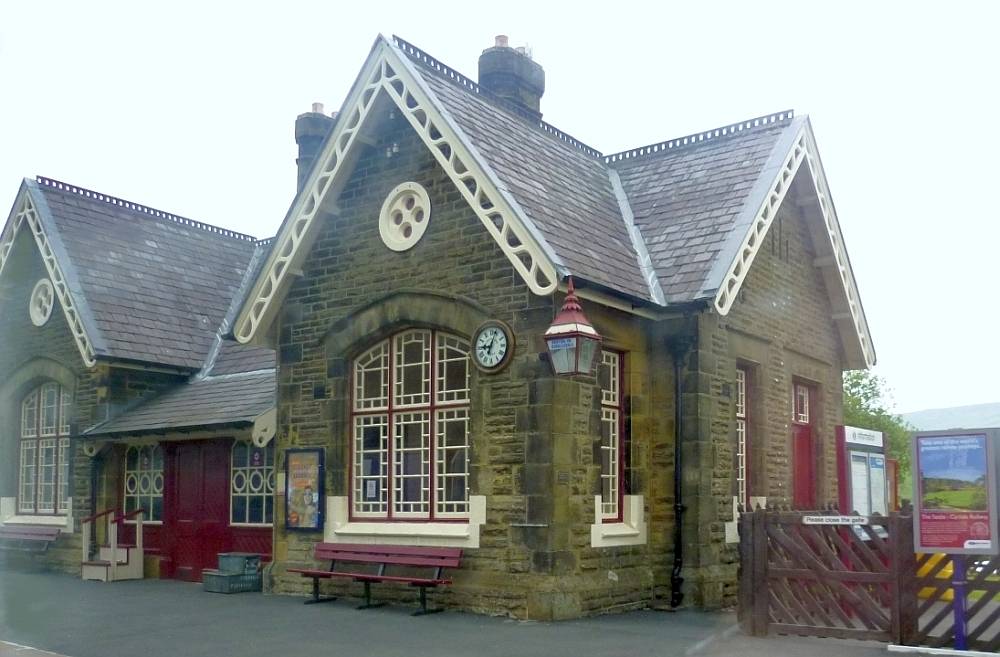

The station at Horton-in-Ribblesdale, an example of Sanders's Type C design.
The Type C station, which is more compact than that at Settle, represents Sanders's smaller station design (see "Stations"). There were three sizes in all, reflecting the relative importance of the station stops. Like the size, the decorative touches vary: the bargeboards and ironwork here are differently patterned from Settle's and quatrefoils instead of trefoils appear in the gable stonework. The "curtain wall" between the two big casements has two smaller windows with a window-guard design of their own. "There seemed no obvious pattern to the variations along the line; one theory was that it related to the four building contracts under which the line was constructed," writes John Pendlebury, pointing out too that the palette was limited. Yet the result was to give the stations a strong sense of corporate identity, with just enough variety to give each a little character of its own. This station is particularly well kept and welcoming. The station-master's house is as little lower down and more sheltered, similar in style to the station itself, but with two storeys. Ribblehead Station, at the next stop, is very similar, its main interest lying in its location just before the famous 24-arch Ribblehead Viaduct.

Dent, the next station after Ribblehead and the highest mainline station in England.
At 1150' above sea-level, Dent (above), which has the distinction of being the highest mainline station in England (Leach and Pevsner 233). One of its special features is the extended roof over the "curtain wall," to give further protection form the elements. Another is the use of snow fences, made from old upright railway sleepers — not the neat fence shown here, although this might also help to trap the snow. When the station buildings were restored, such features were retained wherever possible, though, wisely, the plan was "to take an aesthetic rather than an archaeological approach," and to base finer details only on what was already there, so that "their replication could be properly informed and not based on conjecture" (Pendlebury).
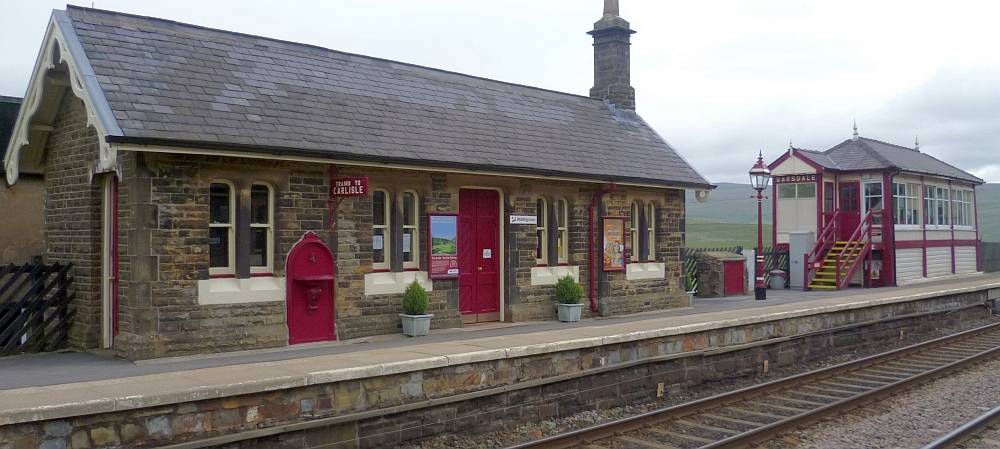
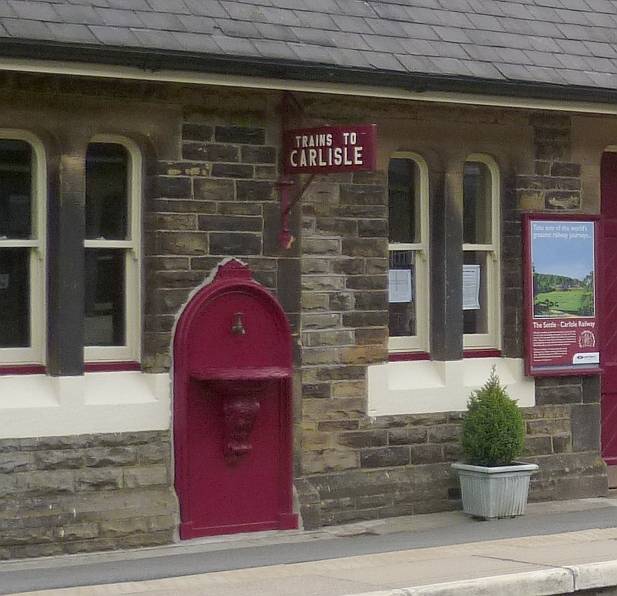
Garsdale Station (formerly Hawes Junction) — an exception to Sanders's general pattern, since it has no gables.
After Dent comes Garsdale Station, once called Hawes Junction because passengers used to be able to change here for another line through Wensleydale (see Scholes 26). In the midst of fell-land, the station building here is an exception to Sanders's general pattern, since it has no gables. Practically at the summit of the line, it has some special features all its own, including what were once "the world's [not just England's] highest water troughs" for the steam trains passing through, and a turntable where high winds "once sent an engine spinning out of control" (Toothill and Armstrong 15). The station might seem rather isolated now, but it was once a lively place, with 16 railwaymen's cottages hard by. Garsdale is the only station that still has a fully operational signal-box ("Stations"). Notice the drinking fountain on the station wall. As elsewhere, there is a simple waiting-room building on the opposite platform. This station is just inside the Cumbrian border, and the line moves on now through the south-west of Cumbria towards the promisingly-named Eden Valley.
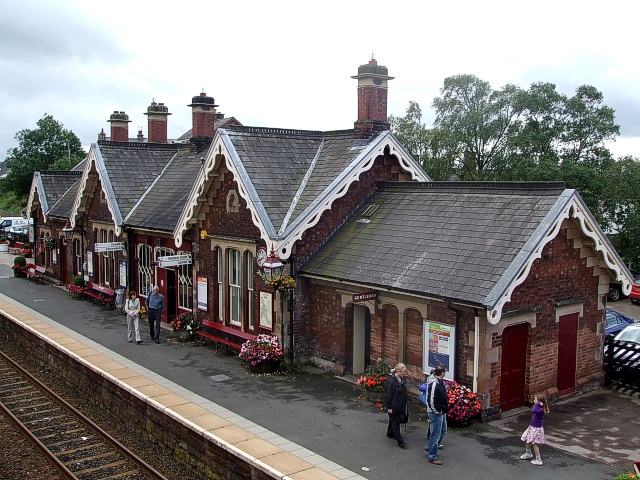
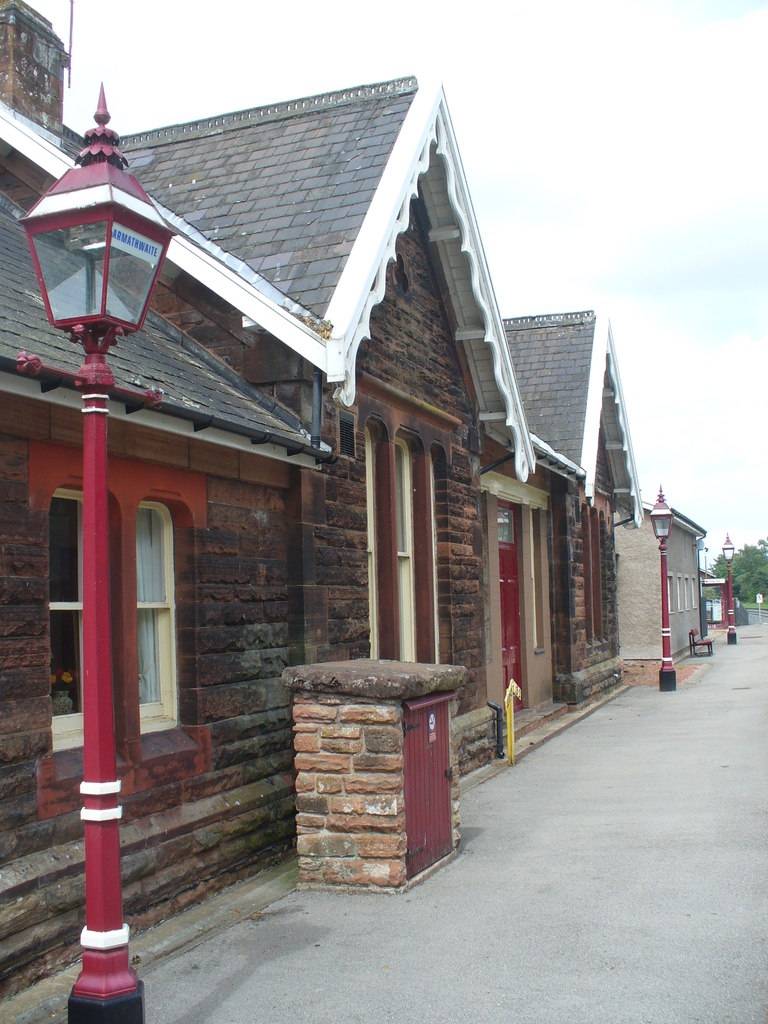
Left: The Station at Appleby (© Rob Farrow) — a large (Type A) station constructed of local materials. Right: Armathwaite Station (© Colin Smith) — a Type B Station.
As the Settle-Carlisle railway travels northwards, the standard building styles are still followed, but the materials change. At Appleby red brick and sandstone were used for the large (Type A) station design. The soil is fertile in the valley of the River Eden, and Appleby was then the bustling county town of Westmoreland. Local people were so pleased when the bill for the new railway was passed that the church bells were rung. "'I have only heard of one dissentient voice in the whole district of Eden Valley,' said a farmer, who sent more than 5000 pounds of butter every year to Sheffield, 'and it came from a gentleman who had a few trees he was partial to'" (Williams 214-15). This station and the one at Settle were, in fact, the only ones to remain open when the stopping service was suspended in 1970. The use of red brick might seem incongruous, as David Toothill and Marian Armstrong suggest (14), but it probably fitted well with the image of Appleby at that time. The hooded chimneypots too are quite distinctive.
Like Lazonby and Langwathby Stations, the next stops along the line, Armathwaite Station is entirely built of local red sandstone, serving as a reminder that the train is now on the last lap of the journey to Carlisle and the Scottish border. This is a Type B or medium-sized station building (see "Stations"), large enough to serve now as a coffee-shop and restaurant. Restoring the buildings and services of the Settle-Carlisle Railway became a cause celèbre in the later part of the twentieth-century, with the splendid results that we see today.
Related Material
- Ribblehead Viaduct
- Dent Head Viaduct
- Arten Gill Viaduct under Construction
- The Yorkshire Dales in Victorian Times
Sources
Conservation Area Appraisals in the Yorkshire Dales National Park: Settle-Carlisle Railway. Yorkshire Dales National Park Authority. Web. 23 August 2011.
Leach, Peter, and Nikolaus Pevsner. Yorkshire West Riding, Leeds, Bradford and the North. The Buildings of England series. New Haven & London: Yale University Press, 2009.
Pendlebury, John. "A Very Peculiar Partnership." Conservation Document. Web 23 August 2011.
Scholes, Ron. Yorkshire Dales. 3rd ed. Ashbourne, Derbyshire: Landmark, 2008.
"Stations" (see individual stations). The Settle-Carlisle Railway. Web. 23 August 2011.
Toothill, David, and Marian Armstrong. The Settle-Carlisle Railway: A Guide to Your Journey: Leeds. Settle. Carlisle. The Settle-Carlisle Railway Development Company, 2010.
Williams, Frederick Smeeton. The Midland Railway: Its Rise and Progress. A Narrative of Modern Enterprise. London: Strahan & Co., 1876. Internet Archive. Web. 23 August 2011.
Last modified 23 August 2011